How Much to Feed Quail Daily
Despite the quail's fragile appearance and reputation, they are quite hardy creatures that are relatively easy to feed. They are picky eaters, but once you understand what quails eat and what they need, it all makes sense.
If you raise other types of barnyard birds, different factors should be considered when raising quails. Factors like breed type, intended use, location of the pen, and climate all play into planning your quails' diets.
To understand your specific covey of quail need, it is crucial to first dig into some details about their natural habitats and diets in the wild.
What Do Quails Eat in the Wild?
You've undoubtedly heard that chickens are omnivores, meaning they eat both meat and plants, but did you know that quail are considered granivores?
Yup, so if it wasn't confusing enough, another "-vore" to learn about.
Granivores have a diet that consists mainly of grains and seeds. However, this does not mean that they won't eat the kind of things that most birds enjoy, like bugs, worms, and plant matter.
In the wild, there are many different breeds of quail living all over the world. There are more than 130 breeds that live in a variety of habitats.
To make things a little easier, we will focus on the most commonly raised breeds in a domestic setting and explore their natural habitat.
Since the bobwhite quail is a popular breed, let's examine its natural habitat to understand its diet more.
A Quail in Its Natural Habitat
Bobwhite quail will set up a house in the grasslands of northern America. They choose to take advantage of a farmer's hard work. They spend their time in fields rich with seeds and grains, such as soybean fields and corn.
Quail tend to target plants that have gone to seed and love noshing on dried seeds that have fallen from their stalks. Some wild plants they enjoy eating seeds from are ragweed, wild sweet peas, and foxtail.
If their food of choice, grains, is not available or in short supply, they have no qualms about seeking out bushy fruits and nuts like raspberries, currants, and bits of acorns.
Lastly, if nothing else, quail will consume a few insects here and there.
In fact, people who want to increase their wild quail population will take extraordinary measures to ensure plenty of bugs are available. For example, they will plant insect-attracting crops or plants in their fields.
These measures help quail living in colder climates prepare themselves for winter by stocking up on bugs' protein.
Protein boosts in insects, worms, and grubs are important for quail, who may not find the grains and seeds they need to survive.
Adult quail prefer grain, and it makes up about 80% of their diet, according to the Michigan DNR.
However, quail under the age of 8 weeks survive and grow due to protein-packed insects' consumption.
Once chicks turn eight weeks old, they are on their own and eating like an adult.
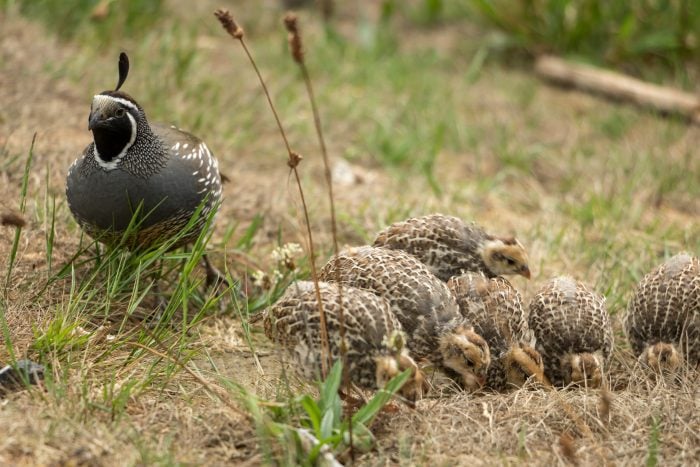
Different Birds Need Different Things
It may be tempting to feed quail other poultry feed types. However, these are not formulated with the necessary vitamins, minerals, and nutrients that a quail needs to survive.
When raising both chickens and quail together, you must know that the way you should feed them will differ.
Some experienced quail farmers use chicken feed for their quail, but they add elements to make up for the deficiency where required.
If you aren't familiar with your quails' dietary needs, consider merely sticking to commercial feed formulated for game birds until you are a bit more experienced.
For example, if the chicken feed is given to quail, the quail will not thrive because the feed is not formulated with the quail's nutritional needs.
If a bird being raised for flight is fed food that you prepared for meat birds, they may not turn out to be the best fliers due to added weight.
Commercial game feeds come in a variety of options based on your birds and their intended purpose.
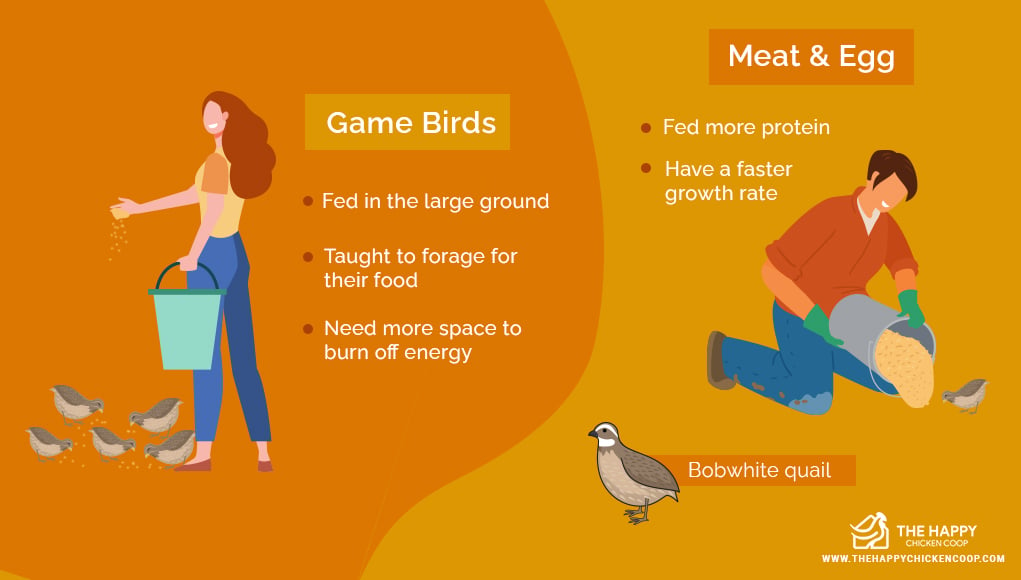
Game Birds vs. Meat and Egg Birds
Bobwhite quail, for example, are usually kept for their meat because they have a faster growth rate than other breeds of quail.
They need to be fed differently from a bird that will need to be conditioned to fly for sporting events, dog training, or release.
Not only will quail being kept for hunting or dog training need to be fed more protein, but they also need more space to burn off energy and learn to fly.
Usually, birds raised as flight birds are given a flight pen–the equivalent of a chicken run for quail.
When flight birds are fed in the large ground or flight pens, they are taught to forage their food when their keepers sprinkle it all over the pen.
As long as the feed is kept out of droppings, this is fine.
The quail then expend energy foraging, they become more active, and if needed, they can survive in the wild if they are released.
So, depending upon what you decide to raise your quail for, plan accordingly.
Captive Quail vs. Wild Quail
Quail are savvy birds, and in the wild, they usually know what they need when they need it. That is why commercial game bird feed is formulated as a complete feed.
This means it provides everything a little quail requires to meet their nutritional needs.
Wild quail will forage grains and seeds and finish their diet with insects, plants, small nuts, and berries.
Since confined birds cannot go out and find what they need to thrive, we must provide it in commercial feeds formulated for your birds.
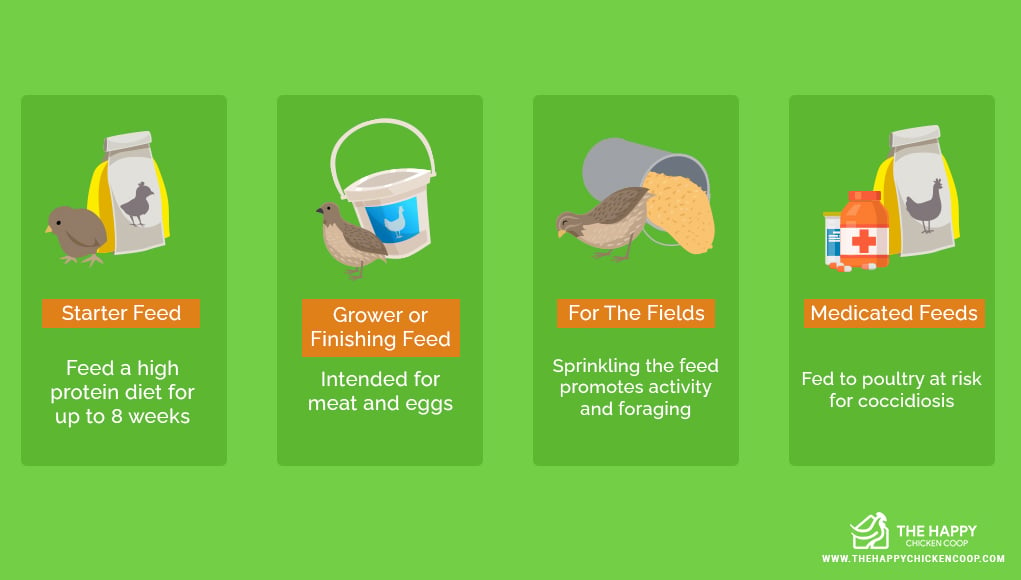
Commercial Game Bird Feed for Quail
Commercial game bird feed is explicitly created for birds from the pheasant family, like grouse, partridges, and of course, quail.
Bags of feed come in many different sizes and feed textures–pellets, mash, and crumble.
Pellets tend to be a bit too big for quail to digest.
Mash can cause hygiene issues in small cages—which may lead to illness; therefore, crumble is your best bet for these itty bitty birds.
Starter Feed
Feed intended for young birds is usually called "starter feed." Unfortunately, it can be challenging to find anything but plain 'ol game bird feed at your local store.
You may need to take a trip to the feed mill and talk with the manager about the right blend for young quail.
Many mill owners are knowledgeable about animal nutrition, and some hire trained animal dietitians. It is worth your time to research your options and tap into the local talent if you can.
Starter feed is packed with protein, which helps young birds grow, and mimics what juvenile quail eat during their first eight weeks in the wild.
That is protein-packed insects. When shopping for a starter feed, look for a game feed that has 30% protein for the best results.
If you only have a handful of baby quail coming, don't go overboard with bags and bags of 40lb starter feed.
These teeny-tiny birds eat very little at the beginning of their lives—like a pinch a day.
Grower or Finishing Feed
Grower feed is also a term used for chicken feed intended for meat chickens and their intense metabolism.
When it comes to game birds raised for meat, the feed may also be referred to as "finishing" feed.
If you plan on growing your quail for the dinner table, you should feed them a 20% protein diet once they reach six weeks of age.
This promotes a healthy growth rate that does not produce excessive fat but still helps build bone mass to support muscle.
For the Fields
Quails raised as flight birds need to be fed a little differently than meat and layers. The amount of protein they consume should be less than that of a meat bird.
This is because many fat and muscle are not conducive to raising a swift flight bird for release.
Not only does the feed need to be different, but the way it is fed should be different. Sprinkling feed promotes activity and foraging, which can prepare quail for the field.
You can find feeds created to promote feather growth for birds intended to fly in the field.
Quail-consuming specially formulated feed will finish out lighter and more prepared for flight during hunting, dog training, or release.
Medicated Feeds
There are varying opinions about feeding quail medicated feed, mostly centered around roosters potentially becoming sterile; however, this has not been proven.
Medicated feed is often fed to poultry at risk for coccidiosis, which causes digestive issues and sometimes death in many poultry species.
Quail is no exception to this rule; thus, some quail owners decide to feed medicated feed for this reason.
Quail chicks are incredibly susceptible to coccidiosis, so medicated starter feed is often used to ward off parasitic infections (like coccidiosis).
If a medicated feed is not something you are interested in, you can prevent coccidiosis by keeping feces out of the feed. Clean the pens regularly.
Some medications can be added to feed if you suspect an infection but always talk to a veterinarian to weigh the additives' pros and cons.
Goldie Locks The Quail
Typically, quail are not picky birds. They don't mind confinement, small spaces, or living indoors.
However, when it comes to their feed, they are a different bird altogether. They prefer that each feed piece is relatively the same size.
If some crumbles are too large or small for their liking, their foraging instinct will kick in. They will pick through their feed, scratching at it, looking for the pieces that are "just right."
Leaving the rest.
Not all feeds are created equal, so assess the brands you are considering.
Try them with your quail, and observe their behavior to ensure they are eating enough and not wasting too much.
Feed Plan for Proper Growth
Here's a quick "cheat sheet" for planning when and what to feed your quail.
- Starter – Feed a high protein diet for up to 8 weeks.
- Grower/Finisher- A feed formulated for quail intended for meat and eggs. Transition to this feed after quail is six weeks old.
- Flight Formulas- Feed formulated for birds intended to be used as sporting flight birds — transition to this feed at six weeks of age.
- Maintenance- Any feed that is called game feed, chow, or maintenance feed. Sometimes you can get layer feeds for egg quails. Usually, this kind of feed has a more generic name. If you keep quail as pets or layers, this is the feed you will transition to after chicks reach 6-8 weeks.
A Quick Note About Free-Choice Feeding
Quail eat until they are full, so providing feed-free-choice is perfectly fine.
You don't have to feed quail a specified amount of feed at certain times of the day. However, they should have access to their feed 24/7.
With that being said, try your best not to overfill feeders because feed can become moldy if it is not consumed within a few days.
Mold can cause illness and death amongst birds. If you see any signs of mold or parasites in the feed, remove it immediately and thoroughly clean the feeder.
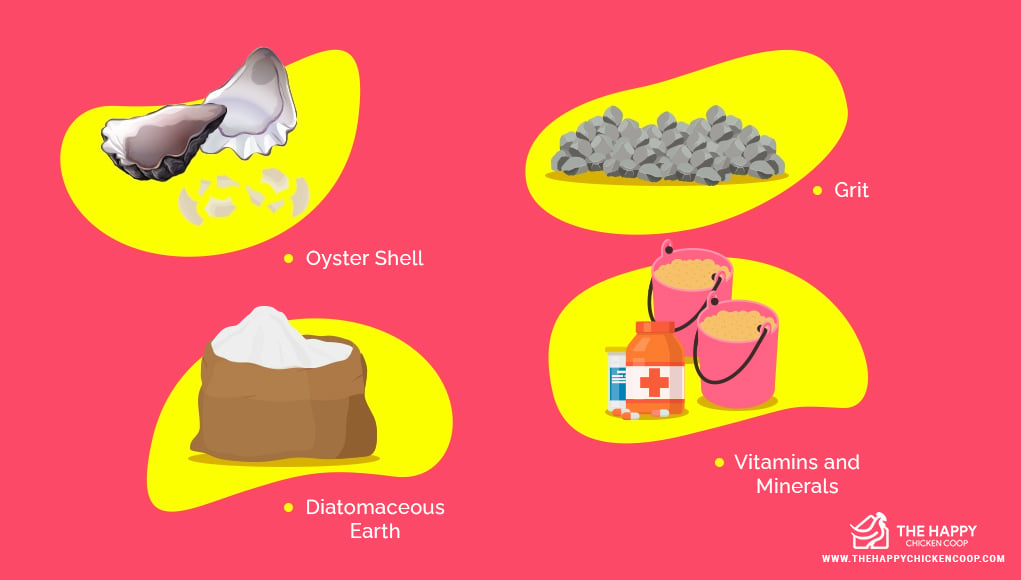
What Else Do Quails Need in Their Diet?
Now that you know what quails need in their diet, let's take a look at what kind of supplements you can add to the menu:
Oyster Shell
Oyster shell is fantastic for layer birds because it provides the amount of calcium needed to produce eggs with strong, thick shells.
Quail can lay one egg per day, so they need a lot of calcium to keep up with reliable egg production. An oyster shell is a perfect solution.
Grit
Like chickens, quail need access to grit, which is just crushed stone; in the wild, quail hunts for their own grit to aid digestion.
Since quail, and chickens, do not have teeth, the crushed stones act as teeth in the birds' crops.
Most quail have crops, but not all do, to break down large grains, seeds, and other matter that needs more processing.
There is a misconception that grit and oyster shells are the same things. However, they quite different.
While oyster shells provide ample amounts of calcium, they are not as useful for breaking down food in the crop as free-choice grit.
Grit can be found in most farm stores and is relatively inexpensive.
Some companies make grit with beneficial additives, like calcium or diatomaceous earth.
Diatomaceous Earth
Diatomaceous earth is a fine dust that is derived from silica and ground fossils. It is used to deter and kill pests around the home, but it is also excellent as a base for your quails' dust baths.
If you suspect that your quails have a mite, flea, or tick infestation, diatomaceous earth can be dusted directly onto your birds and around their pen.
The fine dust will then act as a drying agent, and dry out the pests, eventually killing them.
Ensure that when you purchase diatomaceous earth, it is food grade because your quail will consume it well–which is good for them.
This miracle dust eradicates internal parasites as well.
A word of caution: there is such a thing as too much diatomaceous earth.
If you are coating your pens with it, try only to dust the areas in which pests have been identified.
Since diatomaceous earth is a drying agent, it can dry out and crack your quails' feet, causing pain and possible infections, like bumblefoot.
Vitamins and Minerals
Vitamins and minerals are an essential dietary need for quail. They can find what they need in the grains, seeds, plants, and other scratchings that they forage for in the wild.
However, it is up to you to ensure quail have the vitamins and minerals needed to thrive in confinement.
Different ages of quail need different amounts of vitamins and minerals. Luckily, game bird feed is a complete feed.
This means it includes all of those little extras for your quail and takes out the guesswork.
Packing on the Pounds in Winter
Quail are native to all sorts of hemispheres, and some even live in cold climates where snow accumulates every year.
Unfortunately, quail struggle in these climates because food sources become scarce due to snow cover.
Quail can scratch through a few light inches of snow, but not much more than that.
Due to the quail's high metabolic rate, it can only survive a few days without food.
Quails find crops that have not been harvested fully. They like crops that have dropped many grains and seeds on the field.
Quail will set up camp and try their best to stock up on weight for the winter.
Captive quail need to be given free-choice feed year-round so they can take what they need, especially when the temperatures drop.
They don't have to worry about a food shortage and should be fine over the winter months if given adequate shelter.
A Word About Water
As you probably know, fresh, cool, and clean water every day is crucial for the survival, and health, of your quail.
If you are using a stand-up waterer, be sure it is clear of debris and droppings every day.
Since quail love to scratch for goodies on the ground, they may inadvertently throw their own droppings into their waterers.
Having stagnant, dirty water can become a breeding ground for bacteria that can cause your bird severe health issues.
So keep it fresh and clean!
Another popular type of waterer is an automatic drinking cup , which hangs on the side of your quails' cage.
These little cups have a nipple that only dispenses water when agitated by the quail.
This is the perfect solution if you are short on space and have a tough time keeping your waterers clean.
Treating Your Quail
Quail are cute, irresistible little birds. So many start with one or two quail and find themselves with a ton of these lovely birds.
Sometimes the multiplication of quail is similar to chicken math!
If you are a quail lover that enjoys treating your birds with some fun snacks, there are a few things you can offer them:
Sprouted Seeds
If you can get ahold of some sprouted seeds, like alfalfa, your quail will love you!
Something fresh and different is exciting and tasty for your birds, and hey, they deserve it, right?
If you want to grow your own, check out some different ways to implement a small fodder system for your quail.
You can have freshly sprouted grains regularly if you go this route.

HAPPY GRUBS - ULTIMATE MIXTURE OF WHOLE, HALF, AND POWDER OF BSFL FEED - CHICKEN FEED MIXTURE - 50X-80X More Calcium Than Meal Worms - NON-GMO, Molting Treatment, Great For Wild Birds, Reptiles, Ducks
- Egg Armor For Your Girls Eggs - Mixture of whole, half, bits AND POWDER of black soldier fly larvae that you can mix in your chicken's feed. It increases the strength of your girls' eggshells.
- Healthier Feathers - This product is better than bulk dried mealworms and helps keep your girls' feathers healthy and grow back quicker during molting season.
- Laying More Eggs - Because of the nutrient dense profile of dried black soldier fly larva, your hen's egg production will increase!
- Totally Safe for Reptiles and Other Birds - Happy Grubs is worm food that can also be enjoyed as bird food, reptile food, and turtles as a treat!
- Easy-To-Use Scooper - Our bag comes with a scooper that makes our bsfl mixture and powder easy to pour into a bowl or add to your typical chicken feed. It also has a clip so you can clip it onto the resealable bag. You can use it for feeding your other pets too!
Bugs
Throw a spider or worm into your quail pen and watch the chaos ensue even though a quail's diet is 80% grain.
They love adding buggy protein from time to time. If your quail are in an outdoor pen, they will often "fight" over a tasty insect and chase the lucky birds who found it first.
Quail enjoy worms, grubs, spiders, and any other type of bug they can find.
If you feel adventurous, you can always try your hand at raising insects, or worms, for your quail as a protein boost or treat, when needed.
Veggies
While it's true that quail will eat plant material, it isn't first on their list of favorite things to eat.
You can try giving them vegetable waste from your kitchen scraps, but to be honest, they will probably poke at it a bit and then look at you with an expression that says, "What else ya got?"
Quail are humorous little game birds that aren't difficult to care for.
But when it comes to their diet, they know what they need.
Your quail will thrive if you provide the appropriate feed while they are in your care.
When raising quail, make sure that you feed them a diet that consists of plenty of grains and protein, oh, and make sure the size of their crumbles is consistent.
Don't worry about giving them table scraps…yeah, that just about does it for the plucky, fairly picky quail.
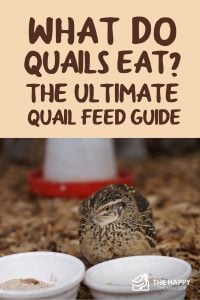
Disclosure: We may earn affiliate commissions at no cost to you from the links on this page. This did not affect our assessment of products. Find full disclosure here.
Source: https://www.thehappychickencoop.com/quail-feed-and-diet/
0 Response to "How Much to Feed Quail Daily"
Postar um comentário